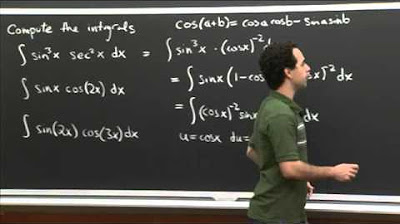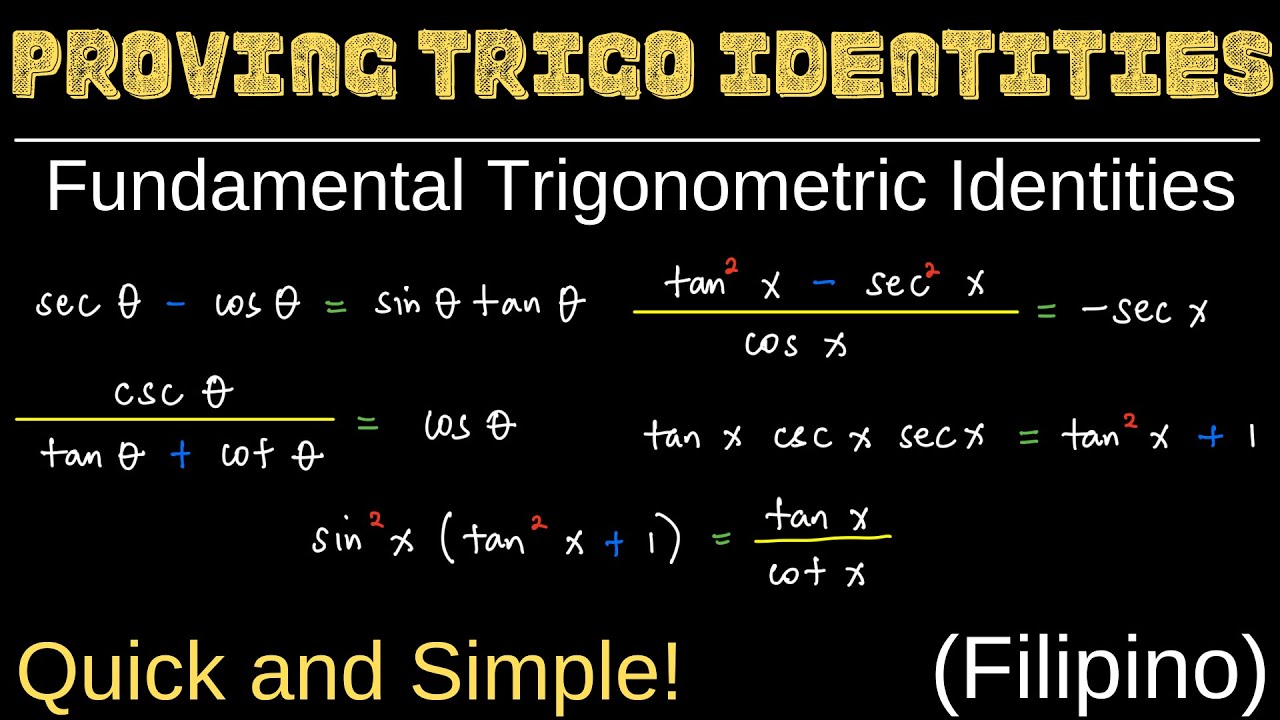5.2.3 Identities in Calculus
TLDRThis video explores the use of identities in calculus, demonstrating how to simplify complex expressions for easier computation or make simple expressions more complex for specific calculus tasks. The instructor presents two examples: transforming cosine cubed of x into a more complex form using trigonometric identities and expanding sine squared times cosine to the fifth power of x into a polynomial expression. The video emphasizes the importance of manipulating expressions to facilitate easier calculus operations.
Takeaways
- 📚 Calculus problems often require using identities to simplify complex expressions for easier computation.
- 🔄 Sometimes, it's necessary to make a simple expression more complicated to simplify the calculus process.
- 🧮 Example 1: Demonstrates how to transform cosine cubed of x into a more complex expression using identities.
- ➗ The transformation involves separating cosine and using the Pythagorean identity: cosine squared of x = 1 - sine squared of x.
- ✅ The multiplication is commutative, meaning the order of multiplication does not matter.
- 🧠 This process proves the identity: cosine cubed of x = (1 - sine squared of x) * cosine of x.
- 📐 Example 2: Shows transforming sine squared of x times cosine to the fifth power of x into a more complex expression.
- 🔄 The transformation involves separating cosine and rewriting cosine to the fourth power using a smaller power.
- 🧩 Use the Pythagorean identity again: cosine squared of x = 1 - sine squared of x, and square it.
- 🔀 Simplify the expression through foiling binomials and combining like terms to match the given identity.
Q & A
What is the main purpose of using identities in calculus?
-The main purpose of using identities in calculus is to simplify complicated expressions for computational ease or, in some cases, to make a simple expression more complicated to facilitate easier calculus operations.
What is the identity involving cosine cubed of x discussed in the video?
-The identity discussed is that cosine cubed of x equals 1 minus sine squared of x times the cosine of x.
How is the identity for cosine cubed of x proven in the video?
-The identity is proven by separating a cosine from the cosine cubed of x, which leaves cosine squared of x, and then using the Pythagorean identity to replace cosine squared with 1 minus sine squared of x.
What is the Pythagorean identity used in the video?
-The Pythagorean identity used is that cosine squared of x is equal to 1 minus sine squared of x.
What is the second example identity discussed in the video?
-The second identity discussed is that sine squared of x times the cosine to the fifth power of x is equal to sine squared of x minus 2 sine to the fourth power of x plus sine to the sixth power of x, all times the cosine of x.
How is the second identity transformed from the simpler left-hand side to the more complicated right-hand side?
-The transformation involves separating a cosine from the sine squared of x, rewriting the cosine to the fourth power as cosine squared squared, and then using the Pythagorean identity and binomial expansion to expand and simplify the expression.
What is the significance of the commutative property of multiplication in the context of the identities discussed?
-The commutative property of multiplication is significant because it allows the order of terms to be rearranged without changing the meaning, which helps in proving and manipulating the identities.
What is the binomial expansion technique used in the video?
-The binomial expansion technique used in the video involves expanding the expression (1 - sine squared of x) squared times the cosine of x, which is done by multiplying out the terms and combining like terms.
How does the video demonstrate the process of simplifying and expanding expressions using identities?
-The video demonstrates this process by first simplifying an expression using a known identity and then expanding a simpler expression to match a more complicated form, using algebraic manipulation and the Pythagorean identity.
What is the final result of the identity transformation shown in the video?
-The final result confirms that the identity is true, showing that the left-hand side matches the right-hand side after all algebraic manipulations are completed.
Outlines
🎓 Introduction to Identities in Calculus
The video begins with an introduction to identities in calculus, highlighting their role in simplifying complex expressions for computational ease. The speaker mentions scenarios where it is necessary to complicate a simple expression to facilitate calculus operations.
🔄 Simplifying Cosine Cubed Expression
An example is provided where the cosine cubed of x is simplified using the identity \( \cos^3(x) = (1 - \sin^2(x)) \cdot \cos(x) \). The speaker explains the process of separating out a cosine term and using the Pythagorean identity to transform the expression, illustrating how the right-hand side, though more complex, is easier for calculus operations.
🔢 Transforming a Sine and Cosine Expression
Another example is discussed where \( \sin^2(x) \cdot \cos^5(x) \) is shown to be equal to \( (\sin^2(x) - 2\sin^4(x) + \sin^6(x)) \cdot \cos(x) \). The process involves taking a cosine term out, rewriting cosine to the fourth power as \( (\cos^2(x))^2 \), and using the Pythagorean identity to simplify the expression. The speaker goes through detailed steps including squaring, foiling, and combining like terms.
🧮 Combining Like Terms and Distributing
The speaker further simplifies the expression by combining like terms inside the parentheses and distributing the sine squared term. This results in the final form \( \sin^2(x) - 2\sin^4(x) + \sin^6(x) \cdot \cos(x) \), matching the right-hand side of the given identity. The confirmation of the identity concludes the example.
✅ Conclusion and Confirmation of Identities
The video concludes with a confirmation that the identities discussed match on both sides of the equations provided. The speaker thanks the viewers for watching and wraps up the lesson on identities in calculus.
Mindmap
Keywords
💡Identities
💡Cosine cubed of x
💡Pythagorean identity
💡Simplification
💡Multiplication is commutative
💡Foiling
💡Cosine to the fifth power
💡Distributive property
💡Trigonometric transformation
💡Verification of identities
Highlights
In calculus, identities can simplify complicated expressions for computational ease.
Sometimes, making a simple expression more complicated can make calculus easier.
Example: Cosine cubed of x equals 1 minus sine squared of x times cosine of x.
Taking a cosine out of cosine cubed of x leaves cosine squared of x.
Using the Pythagorean identity, cosine squared of x can be replaced with 1 minus sine squared of x.
Multiplication is commutative, so the order does not matter in identities.
Proven identity: Cosine cubed of x equals 1 minus sine squared of x times cosine of x.
Second example: Sine squared of x times cosine to the fifth power of x.
Goal: Show that it equals sine squared of x minus 2 sine to the fourth power of x plus sine to the sixth power of x times cosine of x.
Take a cosine out of sine squared of x times cosine to the fifth power of x.
Rewrite cosine to the fourth power of x as cosine squared squared.
Use Pythagorean identity: Cosine squared is 1 minus sine squared of x.
Square 1 minus sine squared of x and foil it out.
Combine like terms in the foiled expression.
Distribute sine squared into the combined expression to match the right-hand side.
Confirmed identity: Sine squared of x times cosine to the fifth power of x equals sine squared of x minus 2 sine to the fourth power of x plus sine to the sixth power of x times cosine of x.
Transcripts
Browse More Related Video

Trig Integral Practice | MIT 18.01SC Single Variable Calculus, Fall 2010

Identities Grade 11: Introduction and practice

Derivative of Sine and Cosine Functions | Calculus

Integrals: Trig Substitution 3 (long problem)

Simplifying Trigonometric Expressions Using Power Reducing Formulas

Proving Trigonometric Identities | Fundamental Trigonometric Identities | Formulas | Part 2
5.0 / 5 (0 votes)
Thanks for rating: